Family | Instrument : Sounding Range | Written Range |
Violin | more ... | 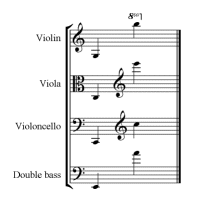 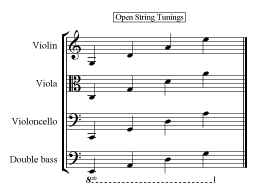 | |
Violino piccolo | more... | ||
Viola | more ... | ||
Viola d'amore | more... | ||
Tenor Violin | more ... | ||
Violoncello piccolo | more... | ||
Violoncello (Cello) | more ... | ||
Double Bass | more ... | ||
Rebec | more... | ||
Renaissance Violin | more... | ||
Baroque Violin | more... | ||
The 20th century Violin Octet | more ... | ||
Pardessus de Viol | more ... | 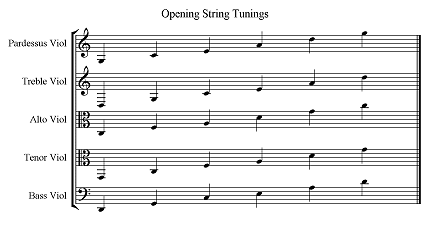 | |
Treble Viol | more ... | ||
Alto Viol | more ... | ||
Tenor Viol | more ... | ||
Lyra Viol | ||
Division Viol | ||
Bass Viol | more ... | ||
Consort of Viols Violone | more... (Italian, literally 'large viol') In modern terminology, the double bass viol, the direct ancestor of the double bass. Historically, the term has embraced a variety of meanings: any viol, a large viol (in particular a low-pitched viola da gamba), and even (in some Italian sources) the cello. The term is known as early as 1520. Electric Viola da Gamba | more... one of the most exciting extensions of this remarkable family of bowed stringed instruments, the Ruby Electric Viola da Gamba is a seven-string bass viol. | ||
Guitar | more ... | 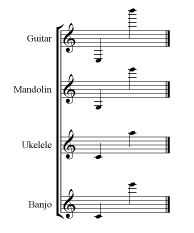 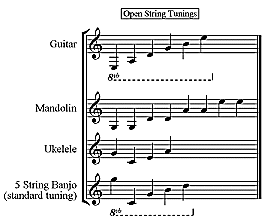 | |
Lute | more ... | ||
Mandolin | more ... | ||
Ukelele/Ukulele | more ... | ||
Five String Banjo | more ... | ||
Early Plucked & Fretted Instruments | more... | ||
Orchestral Harp | more ... | 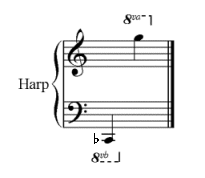 | |
Celtic Harp | more... | ||
Baroque Harp | more... A History of the Harp | ||
Piccolo in C | more ... | 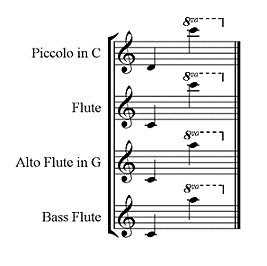 | |
Flute | more ... | ||
Alto Flute in G | more ... | ||
Bass Flute | more ... | ||
Renaissance Flute | more... | ||
Baroque Flute | more ... | ||
Classical Flute | more ... Historical Flutes: general information Rick Wilson's Historical Flute Page | ||
Clarinet in E flat | more ... | 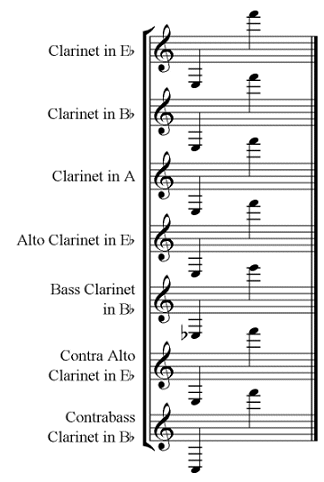 | |
Clarinet in B flat | more ... | ||
Clarinet in A | more ... | ||
Alto Clarinet in E flat | more ... | ||
Bass Clarinet in B flat | more ... | ||
Contra Alto Clarinet in E flat | more ... | ||
Contra Bass Clarinet in B flat | more ... | ||
Sopranino Saxophone in E flat | 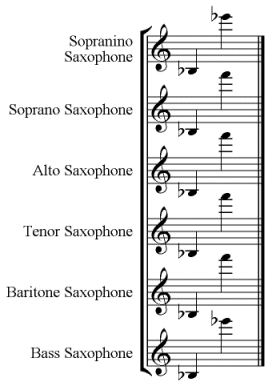 | |
Soprano Saxophone in B flat | ||
Alto Saxophone in E flat | ||
Tenor Saxophone in B flat | ||
Baritone Saxophone in E flat | ||
| Bass Saxophone in B flat sounds one octave plus a major ninth below written pitch Saxophone Family The saxophone was originally patented as two families, each of seven instruments. The "orchestral" family consisted of instruments in the keys of C and F, and the "band" family in Eb and Bb. Each family consisted of Sopranino, Soprano, Alto, Tenor, Baritone, Bass and Contrabass although some of these were never made (Sax also planned - but never made - a subcontra). Of these the orchestral family are now rarely found, and of the band family only the soprano, alto, tenor and baritone are in common use (these form the typical saxophone sections of both military and big bands). The C-melody saxophone, a non-transposing instrument, was popular in the 1920s and could be played from sheet music for guitar and piano. The soprano has regained a degree of popularity over recent decades, and the bass, sopranino and even contrabass are still manufactured. Sopranino, bass and contrabass are rarely used except in large saxophone ensembles and saxophone orchestras. The wide bore of the saxophone means that the larger saxes are extremely large and heavy, and recently (1999) an alternative contrabass, the "tubax," has been developed with a narrower bore. Although not a true saxophone, its bore leads to a more reasonable size and weight. At the other end of the spectrum, construction difficulties mean that only recently has a true sopranissimo saxophone been produced. Nicknamed the "soprillo," this piccolo-sized saxophone is an octave above the soprano, and its diminutive size necessitates an octave key on the mouthpiece. | ||
Oboe | 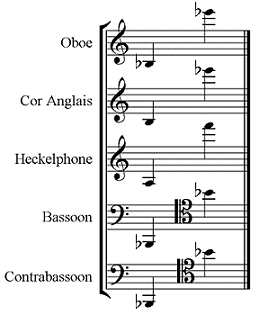 | |
Oboe d'amore in A | more ... | ||
Cor Anglais in F (English Horn) | ||
Heckelphone in C | more ... The piccolo heckelphone is a very rare woodwind instrument. It is a variant of the heckelphone, that is pitched in F, a fourth above the oboe. It was developed and produced by the Wilhelm Heckel GmbH in Biebrich, Germany | ||
Bassoon | ||
Contrabassoon | ||
Piccolo Trumpet in A | 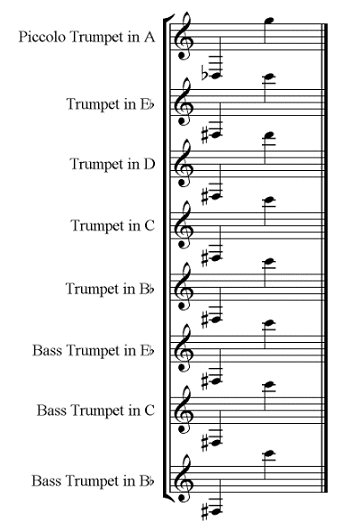 | |
Trumpet in F | ||
Trumpet in E | ||
Trumpet in E flat | ||
Trumpet in D | ||
Trumpet in C | ||
Trumpet in B (rare) | ||
Trumpet in B flat (Cornet) | ||
Trumpet in A | ||
Bass Trumpet in E flat | ||
Bass Trumpet in C | ||
Bass Trumpet in B flat | ||
Alto Trombone | 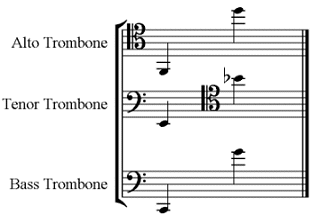 | |
Tenor Trombone | ||
Bass Trombone | ||
French Horn in F | 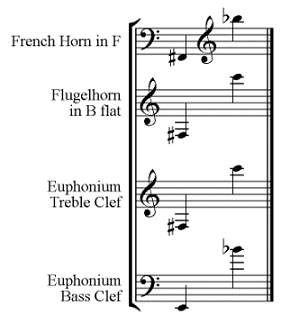 | |
Flugelhorn in B flat | ||
Alto Horn in A | ||
French Horn in G | ||
French Horn in E | ||
French Horn in E flat | ||
French Horn in D | ||
French Horn in C | ||
Baritone Horn (Euphonium) | ||
Baritone Horn (Euphonium) | ||
B flat Tenor Wagner Tuba | 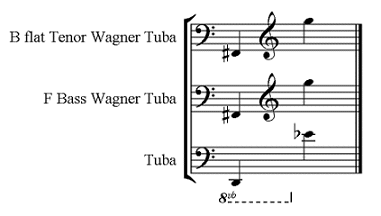 | |
F Bass Wagner Tuba | ||
Tuba | ||
Timpani
|  | |
Glockenspiel | ||
Xylophone | ||
Vibraphone | ||
Tubular Bells | ||
Marimba | ||
Soprano Mezzo-soprano with a range from A below middle C to F an eleventh above middle C, mezzo-sopranos generally have a darker (or lower) vocal tone than sopranos, and their vocal range is between that of a soprano and that of an alto. The terms Dugazon and Galli-Marié are sometimes used to refer to light mezzo-sopranos, after the names of famous singers. A castrato with a mezzo-soprano voice was called a mezzo-soprano castrato | 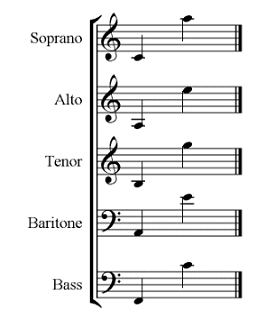 | |
Alto (Contralto) | ||
| Castrato a male voice with the same range as a female soprano (see music dictionary for more information) Countertenor a falsetto male voice with the same range as a female alto (contralto) (see music dictionary for more information) | ||
Tenor | ||
Baritone | ||
Bass | ||
Sopranino in F | 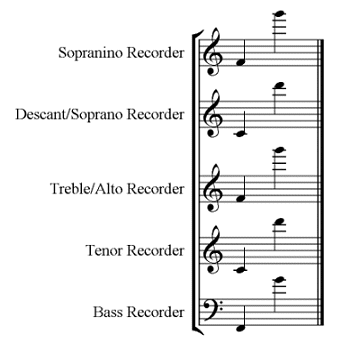 | |
Descant (Soprano) in C | ||
Treble (Alto) in F | ||
Tenor in C | ||
Bass in F | ||
| English | Italian | German | French |
| Recorder | Flauto dolce | Blockflöte | Flûte ā bec |
| Flute | Flauto | Flöte | Flûte |
| Piccolo | Flauto piccolo | Kleine Flöte | Petite Flûte |
| Alto Flute | Flauto contralto | Altflöte | Flûte en sol |
| English Horn (U.S.) or Cor anglais | Corno inglese | Englischhorn | Cor anglais |
| Oboe d'amore | Oboe d'amore | Liebesoboe | Hautbois d'amour |
| Clarinet | Clarinetto | Klarinette | Clarinette |
| Bass Clarinet | Clarinetto basso | Bassklarinette | Clarinette basse |
| Bassoon | Fagotto | Fagott | Basson |
| Contrabassoon | Contrafagotto | Kontrafagott | Contrebasson |
| French Horn | Corno | Horn | Cor |
| Natural Horn | Corno naturale | Waldhorn | Cor simple |
| Valve Horn | Corno ventile or Corno cromatico | Ventilhorn | Cor ā pistons or Cor chromatique |
| Trumpet | Tromba | Trompete | Trompette |
| Cornet | Cornetta | Kornett | Cornet ā pistons |
| Trombone | Trombone | Posaune | Trombone |
| Tuba | Tuba | Tuba | Tuba |
| Drum | Tamburo | Trommel | Tambour |
| Kettle Drums | Timpani | Pauken | Timbales |
| Side Drum | Tamburo piccolo | Kleine Trommel | Tambour militaire |
| Bass Drum | Cassa | Grosse Trommel | Grosse Caisse |
| Cymbals | Piatti | Becken | Cymbales |
| Castanets | Castagnette | Kastagnetten | Castagnettes |
| Triangle | Triangolo | Triangel | Triangle |
| Tambourine | Tamburino | Tamburin | Tambour de Basque |
| Glockenspiel | Campanelli | Glockenspiel | Jue de timbres |
| Xylophone | Xilifono | Xylophon | Xylophone |
| Vibraphone | Vibrafono | Vibraphon | Vibraphone |
| Celesta | Celesta | Celesta | Célesta |
| Harp | Arpa | Harfe | Harpe |
| Strings | Archi | Streicher | Cordes |
| Violin | Violino | Violine | Violon |
| Viola | Viola | Bratsche | Alto |
| Cello | Violoncello | Violoncello | Violoncelle |
| Double Bass | Contrabasso | Kontrabass | Contrebasse |
| Harpsichord, Harpsicon, Harpsical, Cymbel, Clavicymbal | Arpichordo, Cembalo, Clavicembalo, Claricembalo, Gravicembalo | Flügel | Clavecin |
| Virginals | Tafelklavier | Épinette | |
| Spinet, Triangle | Tafelklavier | Épinette | |
| Clavichord |
| Instrument Name | Abbreviation |
| Piccolo | Picc. |
| Flute | Fl. |
| Alto Flute (in G) | Alto Fl. |
| Oboe | Ob. |
| English Horn | E. Hn., (E. H.) |
| Eb Clarinet | Bb Clarinet |
| Clarinet | Cl. |
| Alto Clarinet | Alto Cl. |
| Bass Clarinet | B. Cl. |
| Contrabass Clarinet | Cb. Cl. |
| Bassoon | Bn. |
| Contra Bassoon | C. Bn. |
| Double Bassoon | D. Bn. |
| Saxophone | Sax. |
| Eb Alto Saxophone | A. Sax. |
| Bb Tenor Saxophone | T. Sax. |
| Eb Baritone Saxophone | Bar. Sax. |
| Horn | Hn. |
| Trumpet | Tpt. |
| Cornet | Cor. (Crt., Cnt.) |
| Bass Trumpet | B. Trumpet |
| Trombone | Trb. (Tbn., Tenor) |
| Bass Trombone | B. Tbn. |
| Baritone/Euphonium | Bar. |
| Tuba | Tb. |
| Percussion | Perc. |
| Timpani | Timp. |
| Kettle Drums | K. Dr. |
| Bass Drum | B.D. (B. Dr. ) |
| Snare Drum | S.D.(S. Dr., Sn. Dr.) |
| Tenor Drum | T.D. (T.Dr., Ten. Dr.) |
| Cymbals | Cym. |
| Antique Cymbals | Ant. Cym. |
| Finger Cymbals | fing. Cymbals |
| Gong | G. |
| Tambourine | Tamb. |
| Triangle | Trgl. |
| Castanets | Casts. |
| Chimes/Bells | Bells (Tubular) |
| Glockenspiel/Chime-Bells | Glock. (Glsp.) |
| Bongos | Bong. |
| Claves | - |
| Guiro/Rasper | - |
| Maracas | - |
| Rattle/Ratchet | - |
| Sandpaper Blocks | Sand Bl. |
| Siren | - |
| Slapstick/Whip | - |
| Sleighbells | - |
| Temple Blocks | Temp. Bl. |
| Wind Machine | - |
| Wood Block | Wd. Bl. |
| Xylophone | Xyl. |
| Vibraphone | Vib. |
| Marimba | - |
| Harp | Hp. (Hrp.) |
| Celesta | Cel. |
| Harpsichord | Hpscd. |
| Organ | Org. |
| Piano | P. (Pn., Pft.) |
| Violin | Vn. (Vln.) |
| Viola | Va. (Vla.) |
| Violoncello/Cello | Vc. (Vcl.) |
| Bass | B. |
| Double Bass | Db. |
| Contrabass | Cb. |
| String Bass | St.B. |
| Soprano | S. |
| Alto | A.. |
| Tenor | T. |
| Baritone | Bar. |
| Guitar | Gtr. |
Conductors and orchestras today tend to follow the disposition of instruments established in the 1930s by Leopold Stokowski. He broke with the arrangment that Toscanini, Koussevitzky, Klemperer, Kubelik and Boult had grown up with and were to continue to use to the end of their conducting careers. We illustrate an earlier, pre-Stokowski layout below.
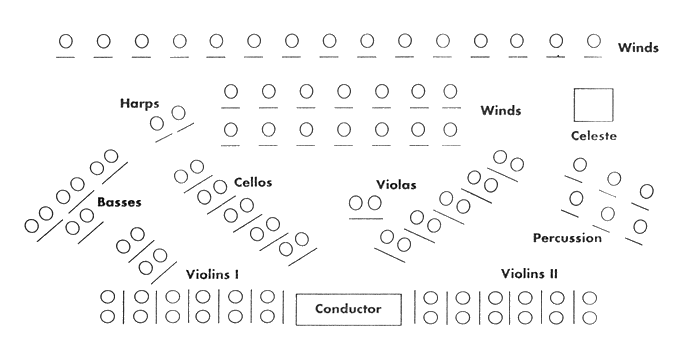
Always innovative, Stokowski changed the layout of an orchestra to suit different halls' acoustics. In the change that was most copied by other orchestras at the time and is still used widely today, Stokowski moved the 2nd violins next to the 1st violins, and placed the violas and cellos sequentially to the 2nd violinist's left. The double-basses were positioned behind and between the violas and cellos. In addition, the percussion was moved to the back of the orchestra. We illustrate this revised layout below.
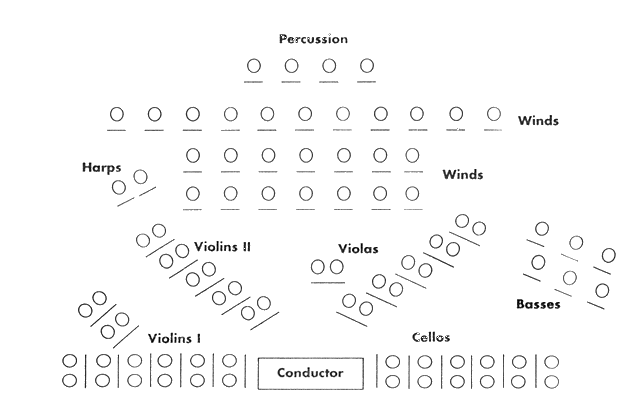
Stokowski changed his orchestra's layout in particular to overcome problems experienced during early monoaural recording. The higher strings tended to play the tune while the lower strings were restricted to the accompaniment. By physically separating the higher and lower strings, Stokowski's recordings emphasised more clearly the role within the musical score that each of different string sections played. Today, however, when recording is invariably in stereo, the Stokowski layout is thought, by some, to create a lopsided effect drawing the listener's attention to the left where the high strings are sitting so spoiling the overall balance.
There has been some interest in returning to the earlier pre-Stokowski layout. For this reason. it should not be assumed that today there is only one standard orchestral layout.
Stokowski interest in optimal orchestral layouts in the recording studio led to some remarkable results.
Robin Maconie in Gossip: The Fantastical Fictions of Baron Stockhausen (1999) writes:
"Despite claims to the contrary, avant-garde music did not erupt spontaneously in 1950. The generation of Boulez, Berio, and Stockhausen was born in a decade of rapid and significant technological innovation. Public radio started up in 1922, electrical recording came on stream in 1925, and sound film in 1927. Already by 1931, when Stockhausen was three years old, conductor Leopold Stokowski and the Philadelphia Orchestra were assisting RCA and Bell Labs in experimental hi-fi stereo broadcasts, and with the arrival of optical sound in 1932 the same team began movie-related experiments in stereo and surround-sound recording. In England at this time Alan Blumlein working for His Master's Voice was single-handedly developing microphone and disc-cutting technology for two-channel 'binaural' sound, some 25 years before stereo was launched commercially in 1956. In the mid-1930s a chance meeting between Stokowski and Walt Disney in a Beverly Hills restaurant led to the commercial development of Fantasound surround-sound technology for the movie Fantasia which eventually premiered with surround-sound in 1941, an incredibly short ten years after the first stereo experiments, and a full fifty years before Dolby Pro-Logic came on the home theatre market."
"These Stokowski sessions throughout the thirties involved experiments in new orchestra layout for optimum balance in front of a microphone, techniques of multiple orchestras, multi-speaker sound systems, and systems of recording and reproducing sounds that appear to rotate around the heads of an audience. The main stumbling-block to reproducing sounds in rotation is preserving phase information which varies with spatial movement according to frequency. There is a kind of Doppler effect that on a sliding scale from low to high stretches or compresses the individual frequencies of a musical sound from a moving source. To reproduce the sound of a moving trumpet for example one has to find a way of reproducing a pattern of frequency alteration that is different for each individual harmonic. A seemingly impossible task, but the team who created Fantasound claimed to have achieved it, perhaps by rotating the microphone and not the player. Now that the remastered original sound-track is freely available on double CD (DSTCD-452 D) it is open to the public to hear and evaluate the surround-sound effect for themselves using an appropriate decoder. The music really does fly. So when Stockhausen in 1971 tells his Cambridge (England) audience an amusing story about asking whether the Cologne chapter of the musicians' union in 1955 would allow players to be suspended in chairs from the auditorium ceiling and rotated over the audience's heads, what the anecdote is really saying is that the audio technicians of North West German Radio had heard about the rotational movement of instrumental sounds in space actually happening in the movie Fantasia but that they couldn't tell him how it was done."
"Radical inventions and discoveries in the field of audio have ways of impacting on musical consciousness even though the relevant technologies remain a mystery to the composers involved. Bartķk's Music for Strings, Percussion and Celesta of 1936 and Sonata for Two Pianos and Percussion of 1937, as well as Bohuslav Martinu's Concerto for Double String Orchestra, Piano and Timpani of 1938 form a cluster of compositions sharing the distinction of being laid out in triptych formation, with central percussion flanked by carefully balanced forces (string orchestras or pianos) to left and right. The deliberately symmetrical layout conforms in a very obvious fashion to the practical requirements of the RCA-Bell three-channel stereo system of 1932. Stokowski does not seem to have been involved in performances of any of these works at this time. In fact both orchestral works were commissioned by the conductor Paul Sacher for his Basel Chamber Orchestra, giving rise to the intriguing question of whether Sacher might have had plans to make a concert film in stereo, perhaps as a counter to Disney's Fantasia, the idea of which was not warmly received in the best musical circles."
When the Royal Festival Hall in London was being designed a lot of time was spent finding the orchestral layout best suited to the players and the audience.
We quote below from The Acoustics of the Royal Festival Hall
"The acoustics team from BRS carried out detailed studies of platform design and orchestral layout, in discussion with various musicians including Malcolm Sargent. It was decided that the platform should be as compact as possible, to avoid time delays between the sounds of different instruments reaching the audience, and thus aid definition. Special music stands were designed, which moved on wheels in grooves along the fronts of the tiers, rather than taking up floor space."
"In keeping with the ‘hill and lake' scheme, the original height of the platform was only 9 inches above the level of the front stalls, with the players arranged on tiers on the platform. After a few years the platform was raised to its present height, largely because soloists did not like performing on such a low stage. It was also realised that a higher platform would assist the projection of sound to the seats under the balcony, by reducing the absorption of direct sound by the audience in the stalls."
"Wooden reflecting surfaces were placed around and behind the platform to assist the players in hearing each other, thereby contributing to the balance and blend of the orchestra. These surfaces also produced short reflected sound paths to the audience, to increase definition of the sound heard. The ‘little lake' required by Bagenal, to reflect sound from the orchestra to the audience, is provided by an area of green slate embedded in the auditorium floor between the stalls and the stage."
"In examining different orchestral layouts, the BRS team considered that placing all the strings on the left, enabling as much string tone as possible to be projected into the hall, would be a successful arrangement."
The public's response was, initially, enthusiastic.
"When the hall opened it was widely praised by audiences, critics, conductors and performers for its clarity, although there was some disquiet over its lack of ‘warmth'. The violinists Jascha Heifetz and Yehudi Menuhin thought it had the best acoustics of any hall they had played in; Joan Hammond the singer ‘found the acoustics excellent'; and the pianist Denis Matthews enjoyed both playing and listening in the hall."
"Among conductors Leopold Stokowski said it was the finest hall in the world; Malcolm Sargent thought the acoustics were excellent; Adrian Boult ‘liked it very much indeed'; and Josef Krips said it was the most perfect hall he knew. Other conductors, however, were more critical. For example, Otto Klemperer cancelled a performance of Elgar's Enigma Variations as he felt the acoustics of the hall were ‘not suited to the sonorities of Elgar's masterpiece.'"
"The hall's extreme clarity allowed even minor errors by players to be heard easily. Bill Allen reported that when he later asked Adrian Boult what he thought of the hall he replied that ‘Malcolm loves it because he is a disciplinarian', whereas he himself preferred York Minster where ‘it doesn't matter if a player is a bar late'!"
"On 9 June 1951, Leopold Stokowski conducted the BBC Symphony Orchestra in Stravinsky's Rite of Spring with the orchestra arranged as suggested by BRS, with all the strings to one side. The music critics present were unanimous in their praise for the sound, commenting on the ‘ideal balance between blend and definition', ‘the richness of the string tone', and the ‘clarity and fullness of tone' of the strings."
"Over the years, criticism by the public and musicians about the lack of warmth, increased. In the early 1960s Peter Parkin invented the system of assisted resonance. Inspiration for the assisted resonance system came from his work in the 1950s on the speech reinforcement system in St Paul's Cathedral. The AR system was tested in the hall in 1964 and installed in 1965, in time for the hall's reopening following major refurbishment. With the system fully operational conductors, performers, critics and audiences agreed that the problem of lack of warmth had been overcome, and that the hall had become one of the best in the world. The system was in use for 30 years before being switched off permanently in the late 1990s."
Contemporary composers have changed the layout of orchestras to clarify the structure of their works. The Sheffield-born composer Bernard Rands, interviewed on a work commissioned by Carnegie Hall in honor of its centennial and given its premiere there under Riccardo Muti's baton on March 18, 1991, comments on the enormous potential in spacing them, reseating or regrouping them "if intelligently handled."
An example of these 'special' layouts is that chosen by Andrzej Panufnik for his symphony entitled Sinfonia Rustica and written in 1948. The composer decided to emulate symmetrical paper-cuts. The orchestral layout is symmetrical with flute, two oboes, two bassoons, two horns and trumpet in the middle of the concert platform, flanked by two string orchestras engaged in ‘stereophonic’ dialogue.
Again with his Sinfonia di Sfere (Symphony no 5) written in 1975, Panufnik utilizes a spherical concept that even affected the composer’s instrumentation. Drums became the dominant force in the orchestration. Three percussionists, each with four drums, are placed around the outside of the platform, arranged so that the sound constantly orbits the orchestra, clockwise or anti-clockwise. Four brass soloists with their circular bells stand as soloists at the centre front of the stage.
Orchestral layout is also something that concerns those keen to give 'historically informed' performances. Jay Nordlinger, reviewing a concert given in the Carnegie Hall February 28, 2001, writes:
"On the stage the following night was a much different orchestra, the Orchestra of St. Luke’s, under Roger Norrington, its former chief conductor. Norrington is a leader of the “original instruments” movement, which is also devoted to “original performance practices.” He is usually a stirring musician, and his program at Carnegie was an appetizing one: a Mahler arrangement of various movements from Bach’s Orchestral Suites; a great and beloved Bach cantata (sung by Emma Kirkby); and the Mahler Fourth (with Kirkby as soloist)."
"Before beginning, Norrington made a little speech to the audience, explaining the links between the pieces to be performed, and offering a little apology, or defense: he is now interested, not only in original instruments and original performance practices, but in “original size,” and original everything else. He and the orchestra would attempt to perform all of these works just as they were done at the time of their debuts. Such things as the layout—the physical layout—of the orchestra would be the same. Most significantly, the strings would use no vibrato (called “the V word” by Norrington). The conductor regretted that we could not know for sure, how the pieces sounded at the moment they were unveiled, in such matters as dynamics. You at times have to wonder whether Norrington and his comrades consider themselves real flesh-and-blood musicians or museum curators. The museum mentality seems to have taken over much of music."
Note: The descriptions above are schematic. That is, they show the general layout for modern orchestras. The exact layout will vary according to the forces required and the space available on the concert platform.
reference:
